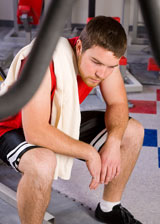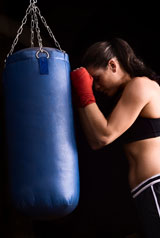Overtraining - How Much Exercise is Too Much?
Overtraining is a mistake many people make when exercising. Selecting the proper exercise intensity, and knowing the signs that you've overdone it, are important to a healthy an effective exercise routine.
Can You Get Too Much Exercise?
The answer to this question is an emphatic YES. This is a mistake I see many people both young and old make, and they are undermining their health when they do it. The assumption is that more is better, and where exercise is concerned, this is not true.

Each of us has an innate capacity for both cardiovascular work output, and strength. We can improve on that by a carefully planned exercise routine, but we are ultimately limited by our genetics, in terms of our ability to perform and recover from intense exercise.
When we work within our genetic limits we can maximize the results. When we go outside of those limits we fail to progress, stagnate, and risk injury. The Lance Armstrongs and Arnold Schwarzeneggers of the world are genetically gifted, while you and I are more likely average in our tolerance to training and exercise intensity.
Exercise Intensity and Exercise Volume
There are two important aspects to exercise. They are exercise intensity and exercise volume. Intensity is the amount of effort you are putting into doing the exercise, whether it is lifting a heavy weight or doing a hard bodyweight exercise like pushups or pull-ups.
Volume is the total amount of exercise you do. For instance, if you lifted 100 lbs 5 times, the exercise intensity would be high and the volume would be low. However if you lifted 50 lbs 15 times, the volume would be higher and the intensity lower.
It is not advisable to do both high intensity and high volume in your exercise program, as the signs of overtraining will begin to show up and you must train lighter or less often, otherwise you will stop progressing, get injured, or both.
When exercising, remember that exercise intensity and exercise volume have an inverse relationship. This means that when the intensity is high, the volume must be low, and when the volume is high, the intensity must be low.
Lets apply this concept to running on a treadmill. I know that these devices allow you to set the grade as well, but lets use a flat run for the example. If you are sprinting, which is running at high speed and exercise intensity, and then your run should be short.
Slower runs can be. To determine how many running sessions per week are ideal, you have to gauge it by feel. When you go into
your next session feeling rested and ready to run hard whatever the speed, then you are recovering properly from session to session and not over-trained.

When you are sore or tired from the last session, you should take an easy workout, which is considered a form of active rest,
or do not run that day, and allow your body complete rest. Feeling tired or sore before exercise is one of the signs of over-training.
The Symptoms
Too much exercise intensity for too long begins to show up in various ways.
- Fatigue and muscle soreness that persists
- Problems sleeping
- Elevated heart rate
- Lack of motivation
- Mild depression
- Weakened immunity
- Loss of appetite
- Weight loss
- Increased incidence of injuries
- Elevated cortisol – requires blood test to measure
Strategies to address over-training include:
- Taking a break or layoff from training
- Massage Therapy
- Nutritional support / supplementation
- Aggressive sports massage
- Hot and cold shower therapy
- Training periodization
- Split training routines
- Slower training pace, less volume and intensity
- Active rest
- Adaptogenic herbs such as Ginseng and Rhodiola
By the time you notice a sign of overtraining, you are already overtrained and need to cut way back on your exercise intensity and exercise volume. You may need complete rest for a while if it is really severe, or just a reduced workload.
There are specific tests that can indicate whether you are overtrained but if you use your instincts and are honest with yourself, you will likely know when you need to reduce your exercise output and allow your body some needed rest.
Moderation is The Key
A good general fitness-training program will allow you to exercise on a regular basis and not get burnt out. Your exercise intensity and exercise volume should vary according to your energy levels, available time, and various stresses and demands in your life.
If you are not an athlete who trains for competitions, then you are better off being cautious about how hard and often you work out. Antiaging requires moderately hard exercise that can be sustained over weeks and months, not extreme workouts!
Your antiaging efforts will be most effective if you exercise hard enough to build and maintain lean muscle mass, and a decent level of cardiovascular function. Beyond that comes a point of rapidly diminishing returns.
Overtraining is a sure sign that where antiaging exercise is concerned you are doing too much! Exercise can become a negative when you take it to extremes, so watch for the signs of overtraining, and adjust your exercise routine to a more reasonable level.
Return to Antiaging Exercise
Return from Overtraining to Longevity and Antiaging Secrets
New! Comments
Care to comment? Feel free to leave your comments below!